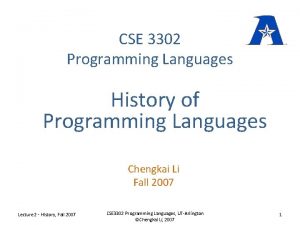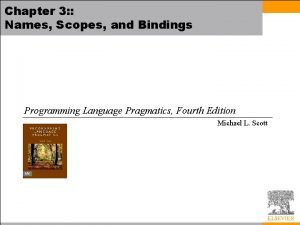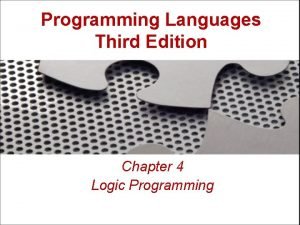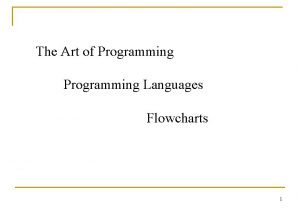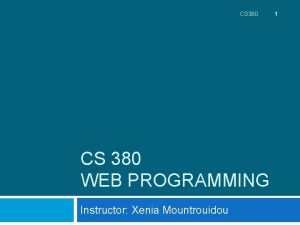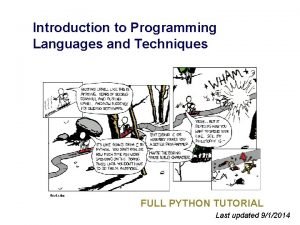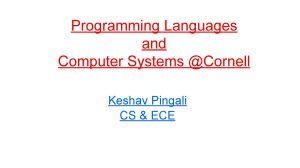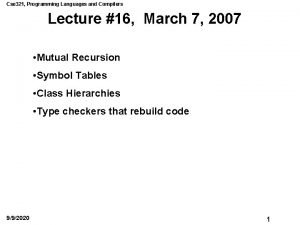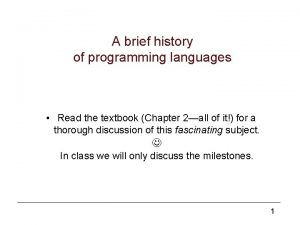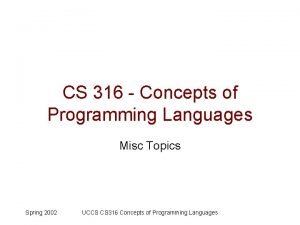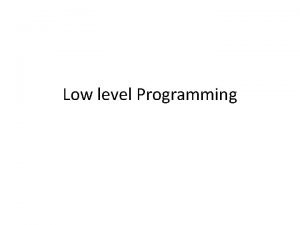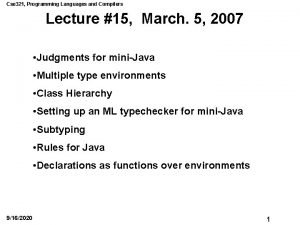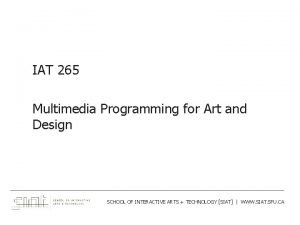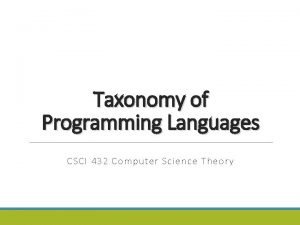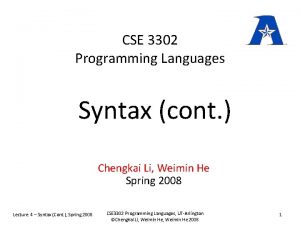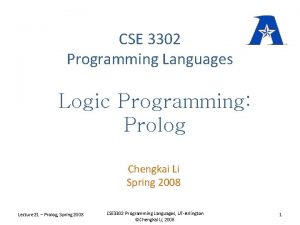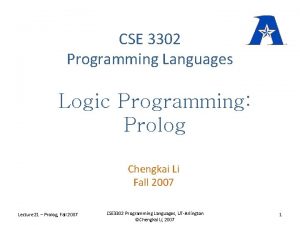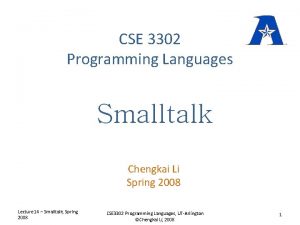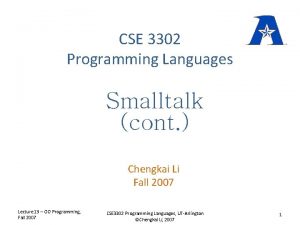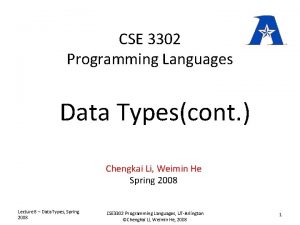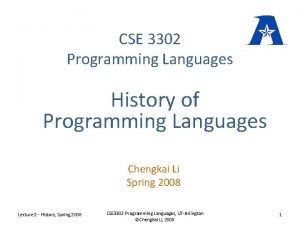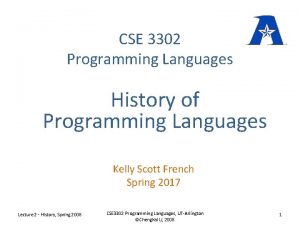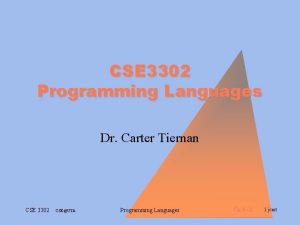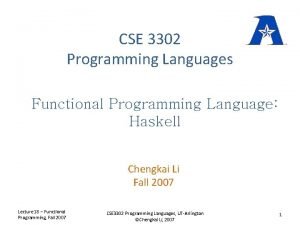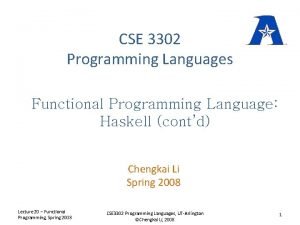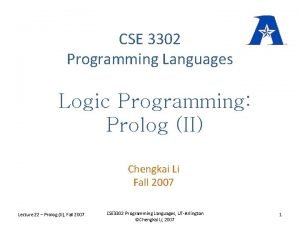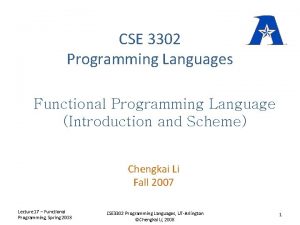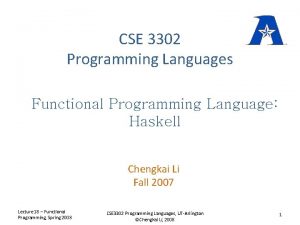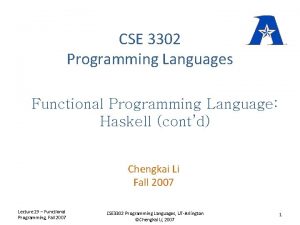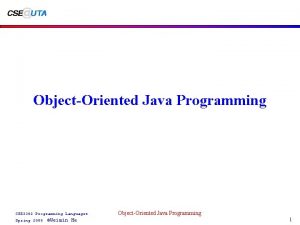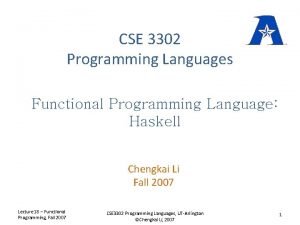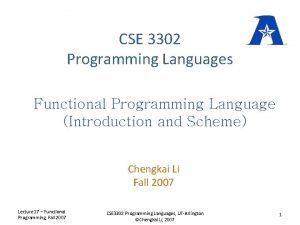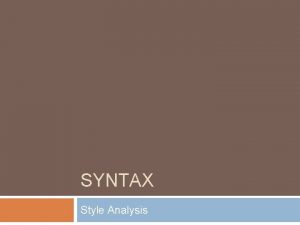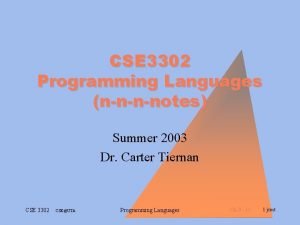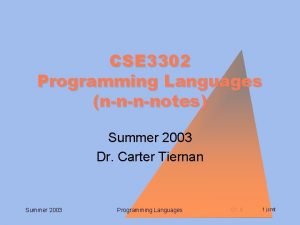CSE 3302 Programming Languages Syntax Chengkai Li Weimin

![Phases of Compilation [Programming Language Pragmatics, by Michael Scott] Lecture 2 - Syntax, Spring Phases of Compilation [Programming Language Pragmatics, by Michael Scott] Lecture 2 - Syntax, Spring](https://slidetodoc.com/presentation_image_h/1c3c9affc9c64f1a8e568e7aea6fcd24/image-2.jpg)







![Indentation in Python def perm(l): for i in range(len(l)): s = l[: i] + Indentation in Python def perm(l): for i in range(len(l)): s = l[: i] +](https://slidetodoc.com/presentation_image_h/1c3c9affc9c64f1a8e568e7aea6fcd24/image-10.jpg)



















- Slides: 29

CSE 3302 Programming Languages Syntax Chengkai Li, Weimin He Spring 2008 Lecture 2 - Syntax, Spring 2008 CSE 3302 Programming Languages, UT-Arlington ©Chengkai Li, Weimin He, 2008 1
![Phases of Compilation Programming Language Pragmatics by Michael Scott Lecture 2 Syntax Spring Phases of Compilation [Programming Language Pragmatics, by Michael Scott] Lecture 2 - Syntax, Spring](https://slidetodoc.com/presentation_image_h/1c3c9affc9c64f1a8e568e7aea6fcd24/image-2.jpg)
Phases of Compilation [Programming Language Pragmatics, by Michael Scott] Lecture 2 - Syntax, Spring 2008 CSE 3302 Programming Languages, UT-Arlington ©Chengkai Li, Weimin He, 2008 2

Syntax and Semantics • Defining a programming language: – Specifications of syntax Syntax – structure (form) of programs (the form a program in the language must take). – Specifications of semantics Semantics - the meaning of programs • Precise definition, without ambiguity – Given a program, there is only one unique interpretation. Lecture 2 - Syntax, Spring 2008 CSE 3302 Programming Languages, UT-Arlington ©Chengkai Li, Weimin He, 2008 3

Purpose of Describing Syntax and Semantics • Purpose – For language designers: Convey the design principles of the language – For language implementers: Define precisely what to be implemented – For language programmers: Describe the language that is to be used • How to describe? – Natural language: ambiguous – Formal ways: especially for syntax Lecture 2 - Syntax, Spring 2008 CSE 3302 Programming Languages, UT-Arlington ©Chengkai Li, Weimin He, 2008 4

Scanning and Parsing • Lexical Structure: The structure of tokens (words) – scanning phase (lexical analysis) : scanner/lexer – recognize tokens from characters • Syntactical Structure: The structure of programs – parsing phase (syntax analysis) : parser – determines the syntactic structure character stream scanner (lexical analysis) Lecture 2 - Syntax, Spring 2008 token stream parser (syntax analysis) CSE 3302 Programming Languages, UT-Arlington ©Chengkai Li, Weimin He, 2008 parse tree 5

Tokens (words): Building blocks of programs • Reserved words (keywords): e. g. , if, while, int, return • Literals/constants: – numeric literal: 42 – string literal: "hello" • Special symbols: e. g. , “; ”, “<=”, “+” • Identifiers: e. g. , x 24, monthly_balance, putchar Lecture 2 - Syntax, Spring 2008 CSE 3302 Programming Languages, UT-Arlington ©Chengkai Li, Weimin He, 2008 6

Reserved words vs. Predefined identifiers • Reserved words: – cannot be redefined. • e. g. , double if; is illegal. • Predefined identifiers: – have initial meaning – allow redefinition (not a good idea in practice) • e. g. , String, Object, System, Integer in Java Lecture 2 - Syntax, Spring 2008 CSE 3302 Programming Languages, UT-Arlington ©Chengkai Li, Weimin He, 2008 7

Principle of Longest Substring • doif vs. do if; x 12 vs. x 12 • The longest possible string of characters is collected into a single token. • An exception: FORTRAN – DO 99 I = 1. 10 (the same as DO 99 I=1. 10) – DO 99 I = 1, 10 Lecture 2 - Syntax, Spring 2008 CSE 3302 Programming Languages, UT-Arlington ©Chengkai Li, Weimin He, 2008 8

White Space • Principle of longest substring requires that tokens are separated by white space. • White space (token delimiters): – Blanks, newlines, tabs – ignored except that they separate tokens • Free-format language: format has no effect on the program structure – Most languages are free format – One exception: python Lecture 2 - Syntax, Spring 2008 CSE 3302 Programming Languages, UT-Arlington ©Chengkai Li, Weimin He, 2008 9
![Indentation in Python def perml for i in rangelenl s l i Indentation in Python def perm(l): for i in range(len(l)): s = l[: i] +](https://slidetodoc.com/presentation_image_h/1c3c9affc9c64f1a8e568e7aea6fcd24/image-10.jpg)
Indentation in Python def perm(l): for i in range(len(l)): s = l[: i] + l[i+1: ] p = perm(l[: i] + l[i+1: ]) for x in p: r. append(l[i: i+1] + x) return r #error: first line indented #error: not indented #error: unexpected indent #error: inconsistent dedent def perm(l): for i in range(len(l)): s = l[: i] + l[i+1: ] p = perm(l[: i] + l[i+1: ]) for x in p: r. append(l[i: i+1] + x) return r Lecture 2 - Syntax, Spring 2008 CSE 3302 Programming Languages, UT-Arlington ©Chengkai Li, Weimin He, 2008 10

Regular Expression • A form for representing sets of strings • Description of patterns of characters • Basic operations: – Concatenation – Repetition – Selection Lecture 2 - Syntax, Spring 2008 CSE 3302 Programming Languages, UT-Arlington ©Chengkai Li, Weimin He, 2008 11

Regular Expression Name epsilon symbol concatenation selection repetition RE a AB A|B A* Shortcuts: A+ = AA* A? = A| [a-z][a-z 0 -9]* Lecture 2 - Syntax, Spring 2008 (a|b)*aa(a|b)* [a-z] = (a|b|. . . |z) [0 -9]+(. [0 -9]+)? CSE 3302 Programming Languages, UT-Arlington ©Chengkai Li, Weimin He, 2008 12

Tasks of a Scanner • Recognizes keywords • Recognizes special characters • Recognizes identifiers, integers, reals, decimals, strings, etc. • Ignores white spaces and comments Lecture 2 - Syntax, Spring 2008 CSE 3302 Programming Languages, UT-Arlington ©Chengkai Li, Weimin He, 2008 13

Scanner regular expression description of the tokens → (Lex or JLex) scanner of a language • Example: Figure 4. 1 (page 82) Lecture 3 - Syntax, Spring 2008 CSE 3302 Programming Languages, UT-Arlington ©Chengkai Li, Weimin He 2008 14

Scanning and Parsing • Lexical Structure: The structure of tokens (words) • Syntactical Structure: The structure of programs regular expression character stream scanner (lexical analysis) Lecture 3 - Syntax, Spring 2008 grammar token stream parser (syntax analysis) CSE 3302 Programming Languages, UT-Arlington ©Chengkai Li, Weimin He 2008 parse tree 15

Example: (1) (2) (3) (4) (5) (6) Grammar sentence ® noun-phrase verb-phrase. noun-phrase ® article noun article ® a | the noun ® girl | dog verb-phrase ® verb noun-phrase verb ® sees | pets Figure 4. 2 (page 83) Lecture 2 - Syntax, Spring 2008 CSE 3302 Programming Languages, UT-Arlington ©Chengkai Li, Weimin He, 2008 16

Grammar • Language: the programs (character streams) allowed • Grammar rules (productions): "produce" the language left-hand side, right-hand side • nonterminals (structured names): noun-phrase verb-phrase • terminals (tokens): . dog • metasymbols: ® (“consists of”) | (choice) • start symbol: the nonterminal that stands for the entire structure (sentence, program). – sentence • E. g. , if-statement ® if (expression) statement else statement Lecture 2 - Syntax, Spring 2008 CSE 3302 Programming Languages, UT-Arlington ©Chengkai Li, Weimin He, 2008 17

Grammars Produce Languages • Language: the set of strings (of terminals) that can be generated from the start symbol by derivation: sentence noun-phrase verb-phrase. (rule 1) article noun verb-phrase. (rule 2) the noun verb-phrase. (rule 3) the girl verb-phrase. (rule 4) the girl verb noun-phrase. (rule 5) the girl sees noun-phrase. (rule 6) the girl sees article noun. (rule 2) the girl sees a noun. (rule 3) the girl sees a dog. (rule 4) Lecture 2 - Syntax, Spring 2008 CSE 3302 Programming Languages, UT-Arlington ©Chengkai Li, Weimin He, 2008 18

Context-Free Grammar • Context-Free Grammars (CFG) – Noam Chomsky, 1950 s. – Define context-free languages. – Four components: • terminals, nonterminals, one start symbol, productions (left-hand side: one single nonterminal) Lecture 2 - Syntax, Spring 2008 CSE 3302 Programming Languages, UT-Arlington ©Chengkai Li, Weimin He, 2008 19

What does “Context-Free” mean? • Left-hand side of a production is always one single nonterminal: – The nonterminal is replaced by the corresponding right-hand side, no matter where the nonterminal appears. (i. e. , there is no context in such replacement/derivation. ) • Context-sensitive grammar (context-sensitive languages) • Why context-free? Lecture 3 - Syntax, Fall 2007 CSE 3302 Programming Languages, UT-Arlington ©Chengkai Li, 2007 20

Backus-Naur Form(BNF) • A meta language used to describe CFG • John Backus/Peter Naur: for describing the syntax of Algol 60. • BNF is formal and precise Lecture 2 - Syntax, Spring 2008 CSE 3302 Programming Languages, UT-Arlington ©Chengkai Li, Weimin He, 2008 21

BNF Example 1 • E → ID | NUM | E*E | E/E | E+E | E-E | (E) ID → a | b |…|z NUM → 0 | 1 | 2 | 3 | 4 | 5 | 6 | 7 | 8 | 9 Lecture 2 - Syntax, Spring 2008 CSE 3302 Programming Languages, UT-Arlington ©Chengkai Li, Weimin He, 2008 22

BNF Example 2 • S → if E then S else S | begin S L | print E L → end |; SL E → NUM = NUM → 0 | 1 | 2 | 3 | 4 | 5 | 6 | 7 | 8 | 9 Lecture 2 - Syntax, Spring 2008 CSE 3302 Programming Languages, UT-Arlington ©Chengkai Li, Weimin He, 2008 23

Parse Tree • Represents the derivation steps from start symbol to the string • Given the derivations used in the parsing of an input sequence, a parse tree has – the start symbol as the root – the terminals of the input sequence as leafs – for each production A → X 1 X 2. . . Xn used in a derivation, a node A with children X 1 X 2. . . Xn Lecture 2 - Syntax, Spring 2008 CSE 3302 Programming Languages, UT-Arlington ©Chengkai Li, Weimin He, 2008 24

Parse Tree Example 1 CFG: expr → expr + expr | expr * expr | (expr) | number → number digit |digit number expr number digit → 0 | 1 | 2 | 3 | 4 | 5 | 6 | 7 | 8 | 9 number digit Input Sequence: 234 digit 4 3 2 Lecture 2 - Syntax, Spring 2008 CSE 3302 Programming Languages, UT-Arlington ©Chengkai Li, Weimin He, 2008 25

Parse Tree Example 2 CFG: expr → expr + expr | expr * expr | (expr) | number → number digit |digit + digit → 0 | 1 | 2 | 3 | 4 | 5 | 6 | 7 | 8 | 9 * Input Sequence: 3+4*5 3 4 Lecture 2 - Syntax, Spring 2008 CSE 3302 Programming Languages, UT-Arlington ©Chengkai Li, Weimin He, 2008 5 26

Abstract Syntax Tree • Parse Tree: still tedious, all terminals and nonterminals in a derivation are included in the tree. • Abstract Syntax Tree: – Remove ``unnecessary’’ terminals and nonterminals – Still completely determine syntactic structure. number digit 2 Lecture 2 - Syntax, Spring 2008 4 digit 3 4 3 CSE 3302 Programming Languages, UT-Arlington ©Chengkai Li, Weimin He, 2008 2 27

AST Example 1 expr + + number expr digit number 3 digit 4 5 Lecture 2 - Syntax, Spring 2008 * expr CSE 3302 Programming Languages, UT-Arlington ©Chengkai Li, Weimin He, 2008 3 * 4 5 28

AST Example 2 expr ( expr Lecture 2 - Syntax, Spring 2008 ) statement else statement CSE 3302 Programming Languages, UT-Arlington ©Chengkai Li, Weimin He, 2008 statement 29
 Cse 3302
Cse 3302 Adam doupe cse 340
Adam doupe cse 340 Cse 340 principles of programming languages
Cse 340 principles of programming languages Syntax directed definition
Syntax directed definition Transmission programming languages
Transmission programming languages Storage management in programming languages
Storage management in programming languages Real time programming language
Real time programming language Cxc it
Cxc it Programing languages
Programing languages The art of programming
The art of programming Comparative programming languages
Comparative programming languages Real-time systems and programming languages
Real-time systems and programming languages Attribute grammar in principles of programming languages
Attribute grammar in principles of programming languages Xenia programming languages
Xenia programming languages Xkcd functional programming
Xkcd functional programming Introduction to programming languages
Introduction to programming languages Cornell programming languages
Cornell programming languages Programming languages
Programming languages Alternative programming languages
Alternative programming languages Cs 421 uiuc
Cs 421 uiuc Cs 421
Cs 421 Brief history of programming languages
Brief history of programming languages Advantages of high level language
Advantages of high level language If programming languages were cars
If programming languages were cars Plc
Plc Low level programming languages
Low level programming languages Programming languages
Programming languages Types of programming languages
Types of programming languages Multimedia programming languages
Multimedia programming languages Taxonomy of programming languages
Taxonomy of programming languages
